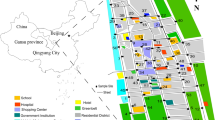Abstract
Performance of busbar insulators is affected by the accumulation of pollutants on their surfaces. The combined action of both the chemical and natural dust pollutants accumulated on the surfaces of the insulators results in the likelihood of surface flashovers. In this paper, the pollution level in terms of equivalent salt deposit density (ESDD) and chemical analyses of a 12-kV generator busbar insulators are carried out to identify the impacts of pollutants presented on the insulators. It is found by actual measurements that the ESDD values of five types of busbar insulators are 0.569, 1.66, 1.61, 1.58, and \(2.44~\hbox {mg}/\hbox {cm}^{2}\), respectively, and all of these values are beyond the acceptable limits. New mathematical models are proposed in between ESDD and chemical anions/cations using a multivariable linear regression analysis. A positive correlation is found between ESDD and cations for the T1-type insulator, whereas for the T5-type insulator, it is found between ESDD and anions.











Similar content being viewed by others
References
Cai W, Deng H, Zhou G, Wang J, Yang F (2013) Online measurement of equivalent salt deposit density by using optical technology. IEEE Trans Dielectr Electr Insul 20(2):409–413
Douar MA, Mekhaldi A, Bouzidi MC (2010) Flashover process and frequency analysis of the leakage current on insulator model under non-uniform pollution conditions. IEEE Trans Dielectr Electr Insul 17(4):1284–1297
Ferreira TV, Germano AD, da Costa EG (2012) Ultrasound and artificial intelligence applied to the pollution estimation in insulations. IEEE Trans Power Deliv 27(2):583–589
Shariati MR, Vaseai SJA, Rezaei M, Abyazi S (2006) New approaches to study environmental pollution effects on insulation of West Azarbayjan Electric Power Distribution Co. In: IEEE Power India Conference, New Delhi, pp 1–7
Jiang X, Shi Y, Sun C, Zhang Z (2010) Evaluating the safety condition of porcelain insulators by the time and frequency characteristics of LC based on artificial pollution tests. IEEE Trans Dielectr Electr Insul 17(2):481–489
Abouelsaad MA, Abouelatta MA, Arafa B, Ibrahim ME (2013) Environmental Pollution Effects on Insulators of Northern Egypt HV Transmission Lines. In: IEEE conference on electrical insulation and dielectric phenomena, Shenzhen, pp 35–38
Salam MA, Ang SP, Ong BT, Malik OA, Voon W, Alinurrezan M (2013) Measurement of pollution level of 66 kV transmission line insulators. In: IEEE conference on electrical insulation and dielectric phenomena, Shenzhen, pp 1124–1127
Lu X, Chen X, Zhang D, Zhang Z (2013) Analysis on natural contamination depositing characteristics of imitative insulator string for overhead transmission line in Shantou. In: IEEE conference on electrical insulation and dielectric phenomena, pp 1124–1127
Salam MA, Goswami H, Nadir Z (2005) Determination of equivalent salt deposit density using wind velocity for a contaminated insulator. J Electrost 63(1):37–44 (Elsevier Science)
Salam MA, Aamer K, Hamdan A, Hamdan N (2003) Study the relationship between the resistance and ESDD of a contaminated insulator-A Laboratory Approach. In: Proceedings of the IEEE 7th international conference on properties and application of dielectric materials, ICPADM’2003, S15-5, pp 1032–1034
Zhang Z, Zhang D, Jiang X, Liu X (2014) Study on natural contamination performance of typical types of insulators. IEEE Trans Dielectr Electr Insul 21(4):1901–1909
Zhongyi Y, Jiang X, Zhang Z, Zhang D, Youchao L (2015) Electrical property of different types insulator string under typical pollution constituents. In: IEEE conference on electrical insulation and dielectric phenomena (CEIDP), pp 170-175, Ann Arbor, Michigan, 18–21 Oct 2015
Nelson JP, Billman J, Bowen J, Martindale D (2014) The effects of system grounding, bus insulation and probability on arc flash hazard reduction—part 2: testing. In: IEEE petroleum and chemical technical conference, pp 29–43, San Francisco, CA, 8–10 Sept 2014
Bychkov PN, Zabrodina IK, Shlapak VS (2016) Insulation contamination of overhead transmission lines by extreme service conditions. IEEE Trans Dielectr Electr Insul 23(1):288–293
Thipprasert W, Jirapong P (2012) Comparison of AC flashover performance for line post and pin post insulators in distribution 22 kV. In: The 9th IEEE international conference on electrical engineering/electronics, computer, telecommunications and information technology (ECTI-CON), pp 1–4, Phetchaburi
Zhou ZC, Zhu MX, Gao S, Zhao CL, Wang LM (2014) Influence of organic pollutants on the pollution flashover properties of porcelain insulators. In: IEEE electrical insulation and dielectric phenomena, pp 345–348, Des Moines, 19–22 Oct 2014
Vinothkumar R, Kannayeram G, Shunmugalakshmi G (2015) Investigation of natural and artificial contamination on various types of insulators. In: International conference on innovations in information, embedded and communication systems (ICIIECS), pp 1–6, Coimbatore, 19–20 Mar 2015
Sangkasaad S, Staub B, Marangsree B (2000) Electrical performance of semiconducting glazed insulators under natural pollution in Thailand. In: IEEE power engineering society winter meeting, pp 2834–2837, 23–27 Jan 2000
IEC60507 International Standard (2013) Artificial pollution tests on high-voltage ceramic and glass insulators to be used on a. c. systems, TC/SC: TC 36-insulators, edition 3.0, pp 1–77
Radojevic M, Lim LH (1995) A rain acidity study in Brunei Darussalam. Water Air Soil Pollut 85(4):2369–2374
Tahir Norhayati Mohd, Suratman Suhaimi, Fong Foo Toon, Hamzah Mohd Suhaimi, Latif Mohd Talib (2013) Temporal distribution and chemical characterization of atmospheric particulate matter in the eastern coast of Peninsular Malaysia. Aerosol and Air Qual Res 13:584–595
http://aqicn.org/city/brunei. 28 Mar 2017
Author information
Authors and Affiliations
Corresponding author
Rights and permissions
About this article
Cite this article
Salam, M.A., Rahman, Q.M., Ahmed, M.U. et al. A new mathematical model for equivalent salt deposit density and chemical anions and cations of busbar insulators. Electr Eng 100, 1277–1285 (2018). https://doi.org/10.1007/s00202-017-0585-4
Received:
Accepted:
Published:
Issue Date:
DOI: https://doi.org/10.1007/s00202-017-0585-4




